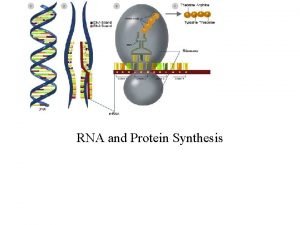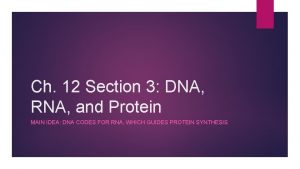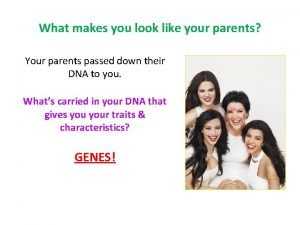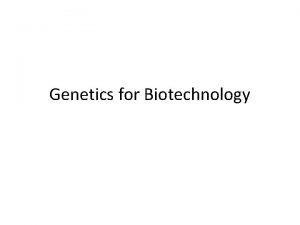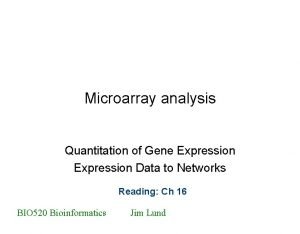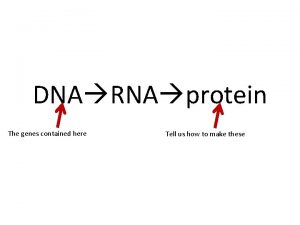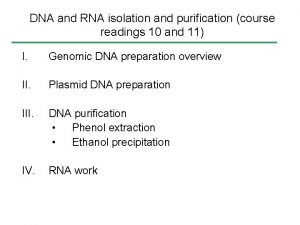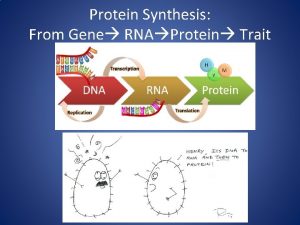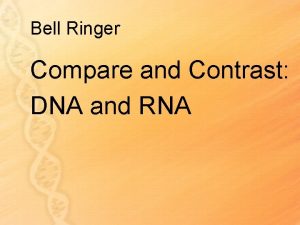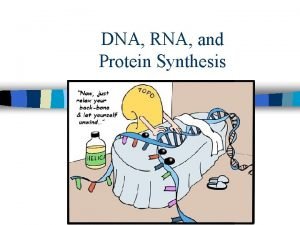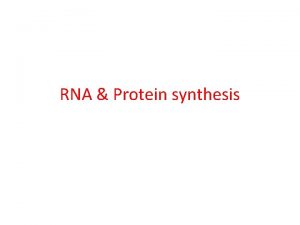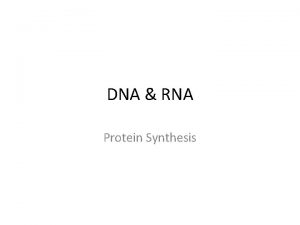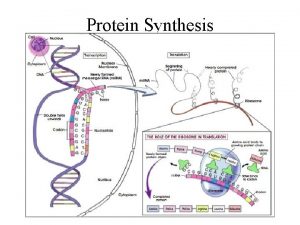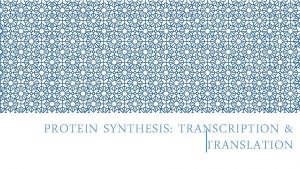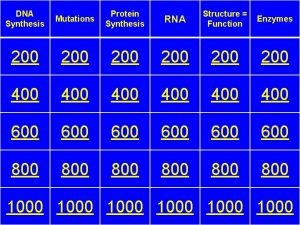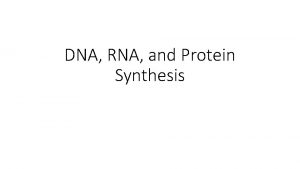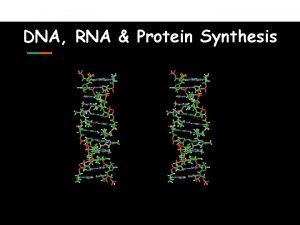RNA and Protein Synthesis The Function of DNA














- Slides: 14

RNA and Protein Synthesis

The Function of DNA The DNA molecule contains all of your hereditary information in the form of genes. Genes are portions of the DNA molecule that code for the production of specific types of proteins. However, DNA is confined to the nucleus, while proteins are made by ribosomes in the http: //www. accessexcellence. org/RC/VL/GG/images/genes. gif

Comparing DNA and RNA is the nucleic acid that acts as a messenger between DNA and the ribosomes. The RNA produced during transcription is structurally different from DNA in 3 basic ways: 1. The sugar in RNA is ribose whereas the sugar in DNA is deoxyribose. 2. RNA is single stranded while DNA is double stranded. http: //www. dkimages. com/discover/previews/769/85011519. J PG

The Role of RNA molecules have many functions, but in the majority of cells, most RNA molecules are involved in protein synthesis. Protein synthesis is the assembly of amino acids into proteins.

Types of RNA The RNA produced during transcription is modified into 3 basic types: 1. messenger RNA (m. RNA) copies one segment (or gene)on one strand of DNA in the nucleus and carries that information to the ribosome. 2. ribosomal RNA (r. RNA) makes up a large part of the ribosome and is responsible for reading and decoding m. RNA. 3. transfer RNA (t. RNA) carries amino acids to the ribosome where they are joined to form proteins. http: //images. encarta. msn. com/xrefmedia/zencmed/targets/illus/ilt/T 068340 A. gif

Protein Synthesis During protein synthesis, genes copied onto RNA are expressed by the production of specific types of proteins. Protein synthesis involves two processes: 1. Transcription – process in which a RNA copy of a segment (gene) of DNA is made. 2. Translation – the decoding of m. RNA message into a polypeptide chain (protein).

Transcription occurs on the DNA in the nucleus. RNA Polymerase binds to DNA at a promoter and separates the DNA strands. RNA Polymerase uses one strand of DNA as a template to assemble complementary nucleotides into a strand of RNA. Transcribed m. RNA leaves the nucleus and goes to the ribosome.

Transcription Practice DNA: AACTGGTACGTA m. RNA: UUGACCAUGCAU DNA: ATGTTCACTGGA m. RNA: UACAAGUGACCU DNA: GTTCATGCATAT m. RNA: CAAGUACGUAUA DNA: TGCCATCGATTC m. RNA: ACGGUAGCUAAG DNA: CTGATGCTGATA m. RNA: GACUACGACUAU

Decoding m. RNA The sequence of bases in an m. RNA molecule serves as instructions for the order in which amino acids are joined to produce a polypeptide. Ribosomes decode these instructions by using codons, sets of 3 bases that each code for one amino acid. Each codon is matched to an anticodon on the t. RNA to determine the order of the amino acids. http: //www. gwu. edu/~darwin/Bi. Sc 150/One/codon. gif

Translation-occurs in the cytoplasm at the m. RNA ribosomes. attaches to a ribosome Translation begins at AUG, the start codon t. RNA brings an amino acid to the ribosome The t. RNA binds to the m. RNA by matching its anticodon to the codon the m. RNA The ribosome moves along the m. RNA as each t. RNA drops of its amino acid

The ribosome joins amino acids with peptide bonds and the t. RNAs leave the ribosome The process continues until the ribosome reaches the STOP codon The result is a polypeptide. (protein)

Using a Codon Chart A codon chart can be used to determine the sequence of the amino acids in the polypeptide. The m. RNA bases or CODONS are used to find the amino acid. http: //www. safarikscience. org/biologyhome/7_dna/codon _question. png

CODON CHART

Decoding Practice For the following examples, give the appropriate m. RNA sequence and amino acid sequence. (Remember: U replaces T in m. RNA. ) Example 1: DNA: TAC GCA TGG AAT m. RNA: UUA AUG CGU ACC Amino Acids: Met Arg Thr Example 2: Leu DNA: CGT GGA GAT ATT m. RNA: GCA CCU CUA UAA t. RNA: CGU GGA GAU AUU Amino Acids: stop Ala Pro Leu
 Dna rna protein synthesis homework #2 dna replication
Dna rna protein synthesis homework #2 dna replication Dna protein synthesis study guide answers
Dna protein synthesis study guide answers Section 12-3 rna and protein synthesis
Section 12-3 rna and protein synthesis Rna transfer
Rna transfer Chapter 12 section 3 dna rna and protein
Chapter 12 section 3 dna rna and protein Totipotent cell
Totipotent cell Messenger rna codons
Messenger rna codons Dna to protein steps
Dna to protein steps Mutations quiz
Mutations quiz Dna rna protein
Dna rna protein Dna rna protein
Dna rna protein Dna rna protein diagram
Dna rna protein diagram Dna rna protein trait
Dna rna protein trait Compare and contrast dna and rna.
Compare and contrast dna and rna. Dna vs rna
Dna vs rna



